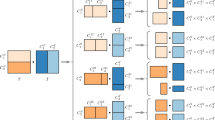Abstract
Shortest paths in weighted directed graphs are considered within the context of compact routing tables. Strategies are given for organizing compact routing tables so that extracting a requested shortest path will takeo(k logn) time, wherek is the number of edges in the path andn is the number of vertices in the graph. The first strategy takesO (k+logn) time to extract a requested shortest path. A second strategy takes Θ(k) time on average, assuming alln(n−1) shortest paths are equally likely to be requested. Both strategies introduce techniques for storing collections of disjoint intervals over the integers from 1 ton, so that identifying the interval within which a given integer falls can be performed quickly.
Similar content being viewed by others
References
A. V. Aho, J. E. Hopcroft, and J. D. Ullman.The Design and Analysis of Computer Algorithms. Addison-Wesley, Reading, Massachusetts, 1974.
T. H. Cormen, C. E. Leiserson, and R. L. Rivest.Introduction to Algorithms. McGraw-Hill, New York, 1990.
N. Deo and C. Pang. Shortest-path algorithms: taxonomy and annotation.Networks, 14:275–323, 1984.
E. W. Dijkstra. A note on two problems in connexion with graphs.Numer. Math., 1:269–271, 1959.
H. N. Djidjev, G. E. Pantziou, and C. D. Zaraliagis. Computing shortest paths and distances in planar graphs.Proceedings of the International Colloquium on Automata, Languages and Programming. Lecture Notes in Computer Science, Vol. 510, pp. 327–338. Springer-Verlag, Berlin, 1991.
R. W. Floyd. Algorithm 97: shortest path.Comm. ACM, 5:345, 1962.
G. N. Frederickson. Implicit data structures for the dictionary problem.J. Assoc. Comput. Mach., 30:80–94, 1983.
G. N. Frederickson. Implicit data structures for weighted elements.Inform. and Control, 66:61–82, 1985.
G. N. Frederickson. Fast algorithms for shortest paths in planar graphs, with applications.SIAM J. Comput., 16:1004–1022, 1987.
G. N. Frederickson. Planar graph decomposition and all pairs shortest paths.J. Assoc. Comput. Mack., 38:162–204, 1991.
G. N. Frederickson. Searching among intervals and compact routing tables.Proceedings of the International Colloquium on Automata, Languages and Programming. Lecture Notes in Computer Science, Vol. 709, pp. 28–39. Springer-Verlag, Berlin, 1993.
G. N. Frederickson. Using cellular embeddings in solving all pairs shortest paths problems.J. Algorithms, 19:45–85, 1995.
G. N. Frederickson and R. Janardan. Designing networks with compact routing tables.Algorithmica, 3:171–190, 1988.
M. L. Fredman. New bounds on the complexity of the shortest path problem.SlAM J. Comput., 5:83–89, 1976.
M. L. Fredman, J. Komlos, and E. Szemeredi. Storing a sparse table withO(1) worst case access.J. Assoc. Comput. Mach., 31:538–544, 1984.
M. L. Fredman and R. E. Tarjan. Fibonacci heaps and their uses in improved network optimization algorithms.J. Assoc. Comput. Mach., 34:596–615, 1987.
F. Harary.Graph Theory. Addison-Wesley, Reading, Massachusetts, 1969.
J. I. Munro and H. Suwanda. Implicit data structures for fast search and update.J. Comput. System Sci., 21:236–250, 1980.
N. Santoro and R. Khatib. Labelling and implicit routing in networks.Comput. J., 28:5–8, 1985.
R. E. Tarjan and A. C.-C. Yao. Storing a sparse table.Comm. ACM, 21:606–611, 1979.
P. Van Emde Boas, R. Kaas, and E. Zijlstra. Design and implementation of an efficient priority queue.Math. Systems Theory, 10:99–127, 1977.
J. van Leeuwen and R. B. Tan. Computer networks with compact routing tables. In G. Rozenberg and A. Salomaa, editors,The Book of L, pp. 259–273. Springer-Verlag, New York, 1986.
S. Warshall. A theorem on boolean matrices.J. Assoc. Comput. Mach., 9:11–12, 1962.
D. E. Willard. Log-logarithmic worst-case range queries are possible in space Θ(n).Inform. Process. Lett., 17:81–84, 1983.
A. C.-C. Yao. Should tables be sorted?J. Assoc. Comput. Mach., 28:615–628, 1981.
Author information
Authors and Affiliations
Additional information
Communicated by C. K. Wong.
This research was supported in part by the National Science Foundation under Grants CCR-9001241 and CCR-9322501 and by the Office of Naval Research under Contract N00014-86-K-0689.
Rights and permissions
About this article
Cite this article
Frederickson, G.N. Searching among intervals and compact routing tables. Algorithmica 15, 448–466 (1996). https://doi.org/10.1007/BF01955044
Received:
Revised:
Issue Date:
DOI: https://doi.org/10.1007/BF01955044




